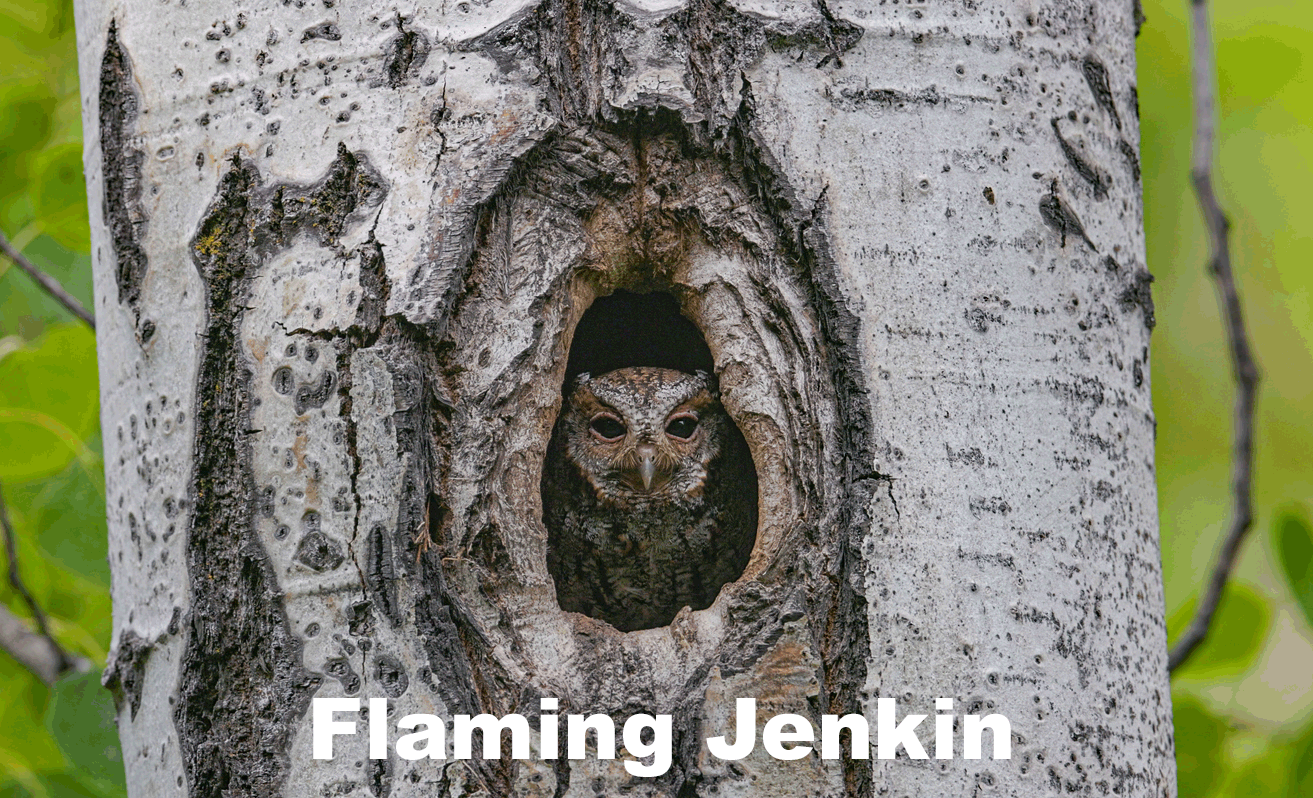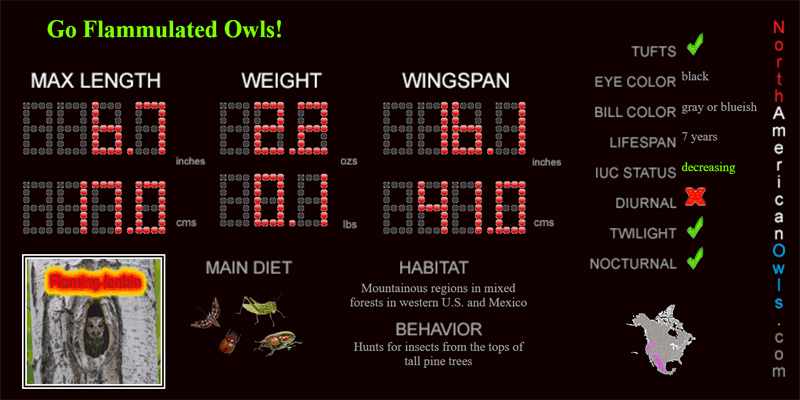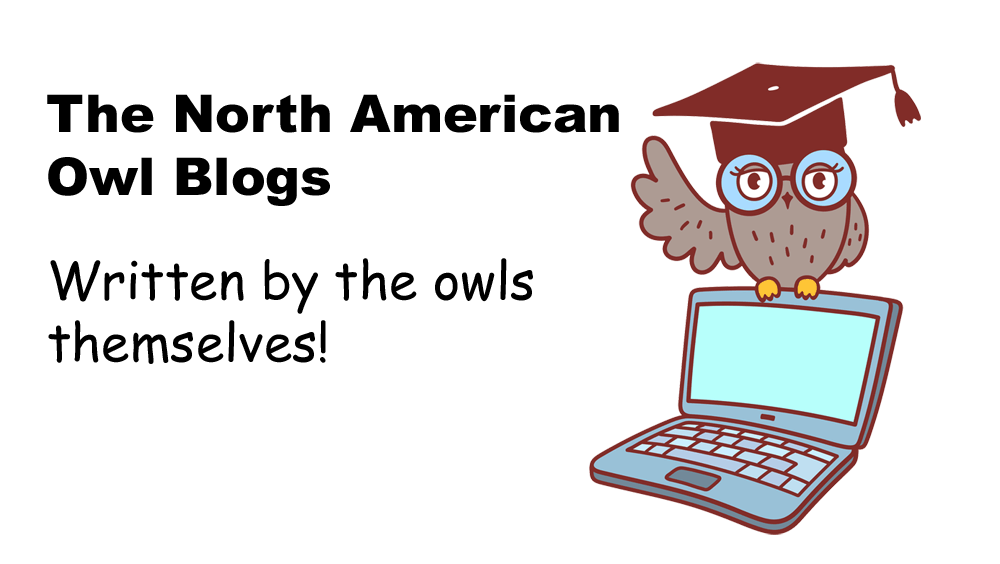
photo credit: Devonyu
Ask Flaming Jenkin
March 5, 2025
EMCEE: Ladies and gentlemen, the Flammulated Owl, Psiloscops flammeolus.
I will make a brief statement and then take your questions. My name is Flaming Jenkin, species representative for the Flammulated Owl. My species lives in the mountainous regions of the western United States, where we show a marked preference for old growth forests, which, I might add, puts us in danger from human development. What, I'm just sayin'. We are a trifle hard to find insofar as we spend much of our time at the top of fir trees, hunting for insects. That's probably why you guys used to think that we were a rare species, whereas we are really just rarely seen, that's all. There is a difference, you know.
But then if you listen closely for us, especially in the higher elevations of the mountains out west, you can make out our vocalizations. From a distance, we sound kind of like the noise that you guys make when you blow air across the opening of a glass soda bottle. You know, it's a sort of hollow, breathy hoot. But if you're lucky enough to be close to us, we sound more like the noise that you make by blowing one of them paper horns you get as a party favor, at least if you were to blow said horn in an apathetic way. Here, listen to this, I will show you what I mean. Ready and... go!
[makes Flammulated Owl call]
Get that? Here, let me do that again.
[makes Flammulated Owl call]
There you have it, the trademark call of Psiloscops flammeolus, the Flammulated Owl. Not bad, huh?
Now then, who has questions?
Jeepers! You look mighty small. You're no bigger than a sparrow. Are you the smallest owl in North America?
No, not quite, but you're getting close. The Elf Owl is the weest of the wee at about 5 inches in length. We are wee too, of course, but we max out at 6 or 7 inches in length.
So you're saying then that you are NOT the weest of the wee when it comes to North American owls?
Oui oui. We are not the weest of the wee. We Flammulated Owls are the SECOND weest of the wee when it comes to North American Owls.
Oui oui?
Oui oui.
I understand that you are an insectivore.
You understand what? Sorry, I guess the Owl Research Institute was right when it claimed that my hearing was not as good as that of other owls.
I said, I understand that you are an insectivore.
Ding ding! Give the man a kewpie doll! You are correct. I may eat the occasional rodent, but my chief M.O. is to snag insects while hanging out at the top of a fir tree.
What kinds of insects?
Large ones, preferably. We're talking grasshoppers and beetles and crickets.
Oh, my!
But we mainly focus on moths!
Interesting.
That's why our owl pellets are made up of chitin rather than bones, as with the larger owls. Because we eat bugs and stuff.
Chitin?
Yes, chitin. That's a kind of glucose derivative found in the exoskeletons of arthropods.
Oh.
Insects are arthropods, you know.
Of course.
As are lobsters and crabs.
Of course.
As are dinosaurs and muskoxen.
Of course.
Gotcha. I was just kidding. Dinosaurs and muskoxen are most certainly NOT arthropods.
Of course.
Oh, be quiet. Next question, please.
Much of what we read about Flammulated Owls is also true of other small owls, like the Northern Pygmy Owl and the Elf Owl.
Your point being...?
Can you tell us something that is special about Flammulated Owls alone?
Well, first you've got our flame-colored patches, which make it look like we were left out in the rain and started to rust.
Cool.
And the female Flammulated Owl is known to sleep while incubating her eggs, a behavior that is not seen in other owls.1
Neat.
There's no harm in multitasking. One more question, please?
I hear you are highly migratory owl?
Come again?
He says he hears that you are a highly migratory owl.
That is true. In wintertime, we are off to Mexico and Central America in search of insects. Even when we are in the States, we tend to move about in search of prey. In spring, we may come down from higher elevations and migrate through the valleys to the north in search of creepy-crawlies, whereas we may check out the higher elevations to our south during the summer and for the same reason.
Funny. I've never seen you guys migrating and I live in the mountainous regions out west.
Ah, yes, but did you know that we migrate at night?
Oh, that explains everything.
We are a nocturnal owl after all.
I see.
You see? You don't see very well at night, I take it. But give me your GPS coordinates and I'll try to remember to hoot the next time I fly through your air space.
Speaking of your species' vocalization, the Audubon Society says that you repeat that call, quote, "almost endlessly."
Yes, that's the Flammulated Owl motto: you can never get too much of a good thing. Besides, it makes it easier for you guys to find us. Speaking of which, I'll hoot for you on my way out of here to remind you of my trademark call: which, all rights reserved, 2025, Psiloscops flammeolus. Ahem, ahem...
[makes Flammulated Owl call]
EMCEE: Ladies and gentlemen, the Flammulated Owl, Psiloscops flammeolus.
1: Flammulated Owl: Psiloscops flammeolus, Owl Research Institute
March 5, 2025
EMCEE: Ladies and gentlemen, the Flammulated Owl, Psiloscops flammeolus.
I will make a brief statement and then take your questions. My name is Flaming Jenkin, species representative for the Flammulated Owl. My species lives in the mountainous regions of the western United States, where we show a marked preference for old growth forests, which, I might add, puts us in danger from human development. What, I'm just sayin'. We are a trifle hard to find insofar as we spend much of our time at the top of fir trees, hunting for insects. That's probably why you guys used to think that we were a rare species, whereas we are really just rarely seen, that's all. There is a difference, you know.
But then if you listen closely for us, especially in the higher elevations of the mountains out west, you can make out our vocalizations. From a distance, we sound kind of like the noise that you guys make when you blow air across the opening of a glass soda bottle. You know, it's a sort of hollow, breathy hoot. But if you're lucky enough to be close to us, we sound more like the noise that you make by blowing one of them paper horns you get as a party favor, at least if you were to blow said horn in an apathetic way. Here, listen to this, I will show you what I mean. Ready and... go!
[makes Flammulated Owl call]
Get that? Here, let me do that again.
[makes Flammulated Owl call]
There you have it, the trademark call of Psiloscops flammeolus, the Flammulated Owl. Not bad, huh?
Now then, who has questions?
Jeepers! You look mighty small. You're no bigger than a sparrow. Are you the smallest owl in North America?
No, not quite, but you're getting close. The Elf Owl is the weest of the wee at about 5 inches in length. We are wee too, of course, but we max out at 6 or 7 inches in length.
So you're saying then that you are NOT the weest of the wee when it comes to North American owls?
Oui oui. We are not the weest of the wee. We Flammulated Owls are the SECOND weest of the wee when it comes to North American Owls.
Oui oui?
Oui oui.
I understand that you are an insectivore.
You understand what? Sorry, I guess the Owl Research Institute was right when it claimed that my hearing was not as good as that of other owls.
I said, I understand that you are an insectivore.
Ding ding! Give the man a kewpie doll! You are correct. I may eat the occasional rodent, but my chief M.O. is to snag insects while hanging out at the top of a fir tree.
What kinds of insects?
Large ones, preferably. We're talking grasshoppers and beetles and crickets.
Oh, my!
But we mainly focus on moths!
Interesting.
That's why our owl pellets are made up of chitin rather than bones, as with the larger owls. Because we eat bugs and stuff.
Chitin?
Yes, chitin. That's a kind of glucose derivative found in the exoskeletons of arthropods.
Oh.
Insects are arthropods, you know.
Of course.
As are lobsters and crabs.
Of course.
As are dinosaurs and muskoxen.
Of course.
Gotcha. I was just kidding. Dinosaurs and muskoxen are most certainly NOT arthropods.
Of course.
Oh, be quiet. Next question, please.
Much of what we read about Flammulated Owls is also true of other small owls, like the Northern Pygmy Owl and the Elf Owl.
Your point being...?
Can you tell us something that is special about Flammulated Owls alone?
Well, first you've got our flame-colored patches, which make it look like we were left out in the rain and started to rust.
Cool.
And the female Flammulated Owl is known to sleep while incubating her eggs, a behavior that is not seen in other owls.1
Neat.
There's no harm in multitasking. One more question, please?
I hear you are highly migratory owl?
Come again?
He says he hears that you are a highly migratory owl.
That is true. In wintertime, we are off to Mexico and Central America in search of insects. Even when we are in the States, we tend to move about in search of prey. In spring, we may come down from higher elevations and migrate through the valleys to the north in search of creepy-crawlies, whereas we may check out the higher elevations to our south during the summer and for the same reason.
Funny. I've never seen you guys migrating and I live in the mountainous regions out west.
Ah, yes, but did you know that we migrate at night?
Oh, that explains everything.
We are a nocturnal owl after all.
I see.
You see? You don't see very well at night, I take it. But give me your GPS coordinates and I'll try to remember to hoot the next time I fly through your air space.
Speaking of your species' vocalization, the Audubon Society says that you repeat that call, quote, "almost endlessly."
Yes, that's the Flammulated Owl motto: you can never get too much of a good thing. Besides, it makes it easier for you guys to find us. Speaking of which, I'll hoot for you on my way out of here to remind you of my trademark call: which, all rights reserved, 2025, Psiloscops flammeolus. Ahem, ahem...
[makes Flammulated Owl call]
EMCEE: Ladies and gentlemen, the Flammulated Owl, Psiloscops flammeolus.
1: Flammulated Owl: Psiloscops flammeolus, Owl Research Institute

Hot News for Psiloscops flammeolus!
January 19, 2025
Want to know who is the Most Flamboyant Owl in North America? Just ask the Academy. They gave the Most Flamboyant Owl award this year to yours truly, The Flammulated Owl, alias Psiloscops flammeolus!
What? Don't tell me you didn't see the North American Owl Awards this year!
Well, better later than never. Check out the North American Owl Awards ceremony, live from Zimman Field at Tufts University in Medford, Massachusetts!
When You're Hot, You're Hot
November 30, 2024
Flaming Jenkin here, all fired up and ready to ignite your interest in Psiloscops flammeolus, the Flammulated Owl. "Flammulated," of course, comes from the Latin word for flame-colored, referring to my reddish-brown feathers1. Our flame-colored feathers contrast with our gray ones to produce some very unique-looking individuals in our species. Check out a variety of F.O. pics online to see whereof I speak2. It's kind of like we Flammulated Owls were originally gray owls, but then we were left out in the rain too long and we started to rust in various places. Depending upon where those places are, we can look funny, flustered, or even ferocious. To paraphrase the Lloyd Price classic, "We've got personality!"
This is good news for you strigophiles because we cannot be easily confused with the other smallish owls that share parts of our far-flung territory (from Mexico to British Columbia), like the Elf Owl and the Northern Pygmy Owl, aka the Mountain Owl. We are all pretty darn small. Depending upon whom you ask, I personally am the size of a soda can3, a smartphone4, or a vinegaroon5, whatever that is. But one look at our coloration, and you'll know whether you're dealing with a Flammulated Owl or not.
Even our calls set us apart from our fellow pipsqueaks. Those other two have high-pitched toots and trills, whereas my vocal range extends to bass notes. The Owl Research Institute explains as follows:
"Unique vocal anatomy of the Flammulated Owl produces a call unlike that of other small owls. The call of this species is hoarse, with low-frequency notes that produce sounds similar to the calls of large owls.6"
But just because we are easy to tell apart by voice does not mean that we are easy to find. To the contrary, we are so hard to find, that we were once considered a rare species in North America. It turns out we are not rare at all, it's just that you guys cannot find us. In the words of the American Bird Conservancy:
"Once considered rare, Flammulated Owls are actually common in scattered locations across their range. However, they can be hard to detect and are most reliably identified by their voice.7"
But hearing us is easier than seeing us. I am a ventriloquist after all. I can throw my voice. So actually finding me can be quite difficult! My call will be ricocheting around the forest, and you'll be like: "What, am I in a funhouse here or something?!"
But I'll give you a tip: Keep looking up. Our nest cavities are 16 feet off the ground, on average8. They have to be for the safety of our chicks. We owls have enemies, after all. Heaven forbid that our nest should be ransacked by a fox, or a mountain lion, or a snake.
Oh, dear, look at the calendar! It's getting late. I'd better be going, I'm afraid. I am a migratory species after all9. I may breed in the States but I spend my winters south of the border, in Southern Mexico and Central America. Hey, Some like it hot, right?
So until next time, Flaming Jenkin is the name, Flammulated Screech Owl is the game!
(singing) Me mind on fire -- Me soul on fire -- Feeling hot hot hot...
Editor's Note: A song? Really? You give some owls a blog and it goes to their head!
Oh, and for the sake of precision, I should add that the Cornell Labs website puts the length of the Northern Pygmy Owl at anywhere between 5.9 and 6.7 inches, somewhere between the size of a sparrow and a robin.10
1: Otus flammeolus flammulated owl, Animal Diversity Web
2: Flammulated Owl - Psiloscops flammeolus, Cornell Lab eBird
3: Exploring the World of the Flammulated Owl with Birdorable, Birdorable
4: Flammulated Owling, Pitta Nature Tours
5: Flammulated Owl : A to Z Guide, Owl Pond
6: Flammulated Owl: Psiloscops flammeolus, Owl Research Institute
7: Flammulated Owl, American Bird Conservancy
8: Where do Flammulated Owls nest?, Birdful.org
9: Unmasking the Long-distance Migration of Flammulated Owls, Bird Conservancy of the Rockies
10: Flammulated Owl Identification, Cornell Lab: All About Birds
copyright 2024 by Brian Quass.
contact: quass@quass.com.
